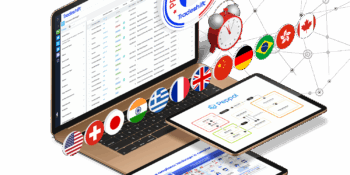Germany’s new multilingual e-Invoicing flexibility: A strategic advantage for global business
Published on: 14 October 2025

By Ioana Ploesteanu
Senior Product Marketing Manager
Tradeshift
About the Author
As part of the Product team, Ioana Ploesteanu partners with marketing and engineering to craft the positioning and lead user engagement strategies for e-Invoicing compliance and AI-driven capabilities.
A fresh alignment with cross-border invoicing needs
Germany is formally allowing e-invoices to be issued in any of the 24 official EU languages, not just German. This is a significant development within the country’s e-invoicing mandate framework, with direct and positive implications for multinational companies, shared service centers, and all cross-border operations.
This article will break down what’s new in Germany, demonstrate how this flexibility benefits global invoicing operations, and highlight how Tradeshift’s global compliance platform—available in 26 languages—is perfectly positioned to support this change and simplify your path to compliance.
What’s new in Germany: The multilingual flexibility and the mandate context
To understand the full significance of the language change, it helps to briefly recap the broader German e-invoicing mandate timeline.
Mandate Background: E-Invoicing in Germany from 2025 to 2028
The push for e-invoicing in Germany is part of a wider European movement toward digital compliance, aligning with the EU’s VAT in the Digital Age (ViDA) initiative.
- Under the Growth Opportunities Act (Wachstumschancengesetz), starting 1 January 2025, certain German taxpayers are required to receive structured e-invoices in the European standard (EN 16931) format.
- The obligation to issue structured e-invoices will be phased in:
- Starting in 2027 for larger taxpayers (those with turnover above ∈800,000).
- By 2028 for all remaining businesses.
- During this transition, paper, PDF, or other non-structured formats may still be used (subject to recipient consent or exceptions) until the full structured issuance becomes mandatory.
Within this framework, Germany’s new language flexibility represents a meaningful enhancement to the invoicing rules.
What Exactly Is Changing: The Language Concession
In a circular issued on 17 September 2024, the German Federal Ministry of Finance (BMF) clarified a key point: invoices issued under the e-invoicing regime may be drawn up in any official EU language, not solely German.
Here are the key takeaways from the BMF circular:
- Language Flexibility: Businesses may issue invoices in any of the EU’s official languages, provided the recipient can clearly understand the invoice and all statutory information required under the German VAT Code (UStG) is present.
- Audit & Translation Rights: While the flexibility is granted, businesses must be prepared. If tax authorities request it during an audit, a German translation of an invoice might be required.
- Input VAT Deduction Unaffected: The ability to deduct input VAT is not impaired by using a non-German language, as long as the invoice is otherwise fully compliant with legal requirements.
- Use of Standardized Terminology: The BMF encourages the use of EU-standardized terms (often sourced from official translations of the EU VAT Directive) to help avoid potential confusion or misinterpretation across languages.
This is a significant structural concession. It acknowledges that Germany operates within a cross-border, multilingual trade ecosystem, making compliance more pragmatic for international companies.
How this benefits companies and cross-border document exchange
The German language update provides tangible operational and financial benefits for any company engaged in cross-border trade with German partners.
1. Reduced translation overhead and costs
Before this regulatory change, companies often had to maintain dual invoice streams—one in German to satisfy perceived compliance requirements, and another in the local language of the recipient or the corporate standard (e.g., English).
The new approach allows businesses to issue the invoice in the customer’s preferred language directly, eliminating duplication, cutting translation costs, and significantly reducing the risk of errors that can occur when generating multiple language versions.
For multinational environments, such as those running Enterprise Resource Planning (ERP) systems or Shared Service Centers (SSCs), this simplification is critical: a single, customer-centric invoice stream can now satisfy both statutory compliance and business usability.
2. Seamless cross-border invoicing and harmonization
By formally accepting all EU languages, Germany is making cross-border invoicing more fluid and harmonized:
- A supplier in Spain can now invoice its German B2B customer in Spanish (or English) without having to generate a separate German-language version.
- Intra-EU flows are streamlined: suppliers can use the same language approach across multiple EU countries (where permitted) instead of building complex country-by-country language transformation rules.
The flexibility strongly supports centralized invoice operations that rely on a single lingua franca (most often English), removing a key point of friction that existed under stricter language constraints.
3. Structural compliance takes precedence over language
It is crucial to understand that language flexibility does not conflict with structural compliance. Germany’s mandate relies on the European standard EN 16931 (delivered via formats like XRechnung or ZUGFeRD).
- The structured data (the machine-readable fields) remains the authoritative source for the tax authorities.
- The human-readable parts of the invoice can appear in any EU language, as long as all mandatory elements map correctly and are included.
- In an audit or verification, authorities will first look at the structured components. The natural language version is a supporting document, and the German translation (if requested) must accurately reflect the structured data.
4. Future readiness and interoperability
This language concession signals Germany’s strong commitment to developing a more internationally-friendly and interconnected e-invoicing regime. It aligns with the direction of ViDA and facilitates integration with cross-border networks like Peppol by pragmatically acknowledging multilingual business realities.
Companies using a truly global compliance platform are best equipped to capture these changes, adapt quickly, and maintain a competitive edge in a continuously shifting regulatory environment.
Tradeshift: Your flexible, global e-Invoicing compliance partner in 26 Languages
At Tradeshift, we’ve always positioned ourselves not just as a compliance vendor but as a strategic partner in global digital transformation. The German language flexibility update underscores and strengthens this commitment.
5 Tradeshift capabilities for navigating this shift
- Multilingual support: Interfaces and document handling are provided in 26 languages. You can set up the platform and use the capabilities to process invoices in your local language.
- Flexible compliance engine: We adapt rapidly to changes in national and regional rules.
- Structured data focus: Our platform prioritizes structured data (EN 16931 or equivalent) for validation and routing.
- Global mandate coverage: Deep, continuously updated compliance across mandates in countries like France, Belgium, Poland, Spain, Australia, Romania, Malaysia, and up to 69 total countries coverage. .
- Compliance orchestration: You gain a single, unified global solution rather than having to bolt on yet another point solution for Germany or other countries.
By design, your global e-invoicing operations can scale in both structure and language without being constrained by local mandates.
Choose Tradeshift as your global e-Invoicing compliance partner
Germany’s decision to permit e-invoices in any official EU language represents a progressive shift in its compliance posture that clearly responds to the realities of global trade, multinational operations, and multilingual corporate needs.
At Tradeshift, we view this change as further validation of a philosophy we’ve long held: compliance platforms must be global, flexible, and multilingual. In a world of ever-shifting mandates, you need a partner that not only keeps pace with regulatory updates but anticipates and embodies the most pragmatic solutions.
With comprehensive support in 26 languages, deep global mandate coverage, and powerful AI-enhanced capabilities embedded across invoice processing, our platform doesn’t just help you align with compliance, it empowers your finance department to lead the digital transformation of invoice operations.
For Finance Managers, Tax Managers, Project Managers, and IT/EDI specialists, our advice is let’s prepare together for the next wave of global e-invoicing.
Get in touch to see how Tradeshift can help you stay ahead.
You may also be interested in
Reducing your compliance risk
We provide e-Invoicing compliance in 69 countries and clearance in 12. It’s our customers’ number 1 issue. Don’t risk fines and repetitional damage. Act now to beat the deadlines
Germany update: e-Invoicing mandate finalised
The Growth Opportunities Act’s (Wachstumschancengesetz) e-Invoicing mandates have been reinforced in the final guidelines, offering greater specificity and clarity. Are you ready?
The future of e-Invoicing and tax compliance: what to expect in the next 5 years
The global shift toward e-Invoicing compliance and real-time tax reporting has been one of the most significant regulatory developments in recent years. In 2024, several countries rolled out their own mandates, including Germany’s e-Invoicing compliance framework, Romania and Malaysia’s tax clearance systems, and France’s phased implementation of mandatory e-Invoicing through designated technology providers.
Enabling global tax compliance
Compliance is a vast domain. Transitioning from paper to electronic invoices (e-invoices) involves one process for complying with B2B e-invoicing mandates using locally compliant document formats, while a separate process is required to ensure tax compliance. Add to the mix the document transactions between suppliers (e-invoice senders) and buyers (e-invoice receivers) from different countries, and you have the recipe for a very complex process. Much like French cuisine, global, cross-border tax compliance is highly sophisticated.



